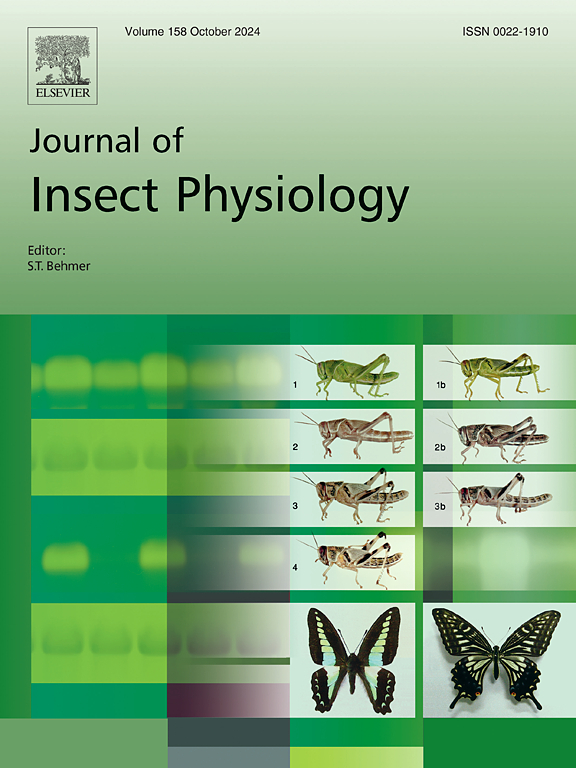Biological fitness of an oligophagous herbivore Chrysomela populi on two different poplars
IF 2.3
2区 农林科学
Q1 ENTOMOLOGY
引用次数: 0
Abstract
Elucidating the mechanism by which oligophagous herbivores adapt to host plants is crucial in determining the co-evolution and interactions between insects and plants. Throughout a co-evolutionary process, the oligophagous herbivore Chrysomela populi L. relied on Populus trees to develop and form specialized larval glandular chemical defenses. However, the current understanding of the growth, development, and chemical defense of C. populi on different Populus trees remains insufficient. Here, the effects of Populus canadensis and Populus tomentosa on the development and chemical defense of C. populi were examined. The larvae develop well on P. canadensis achieving higher pupation and improved survival. In contrast, they only survive up to 2nd instar after feeding on P. tomentosa. Meanwhile, the synthetic salicylaldehyde content in C. populi larvae after feeding on P. canadensis leaves was higher than after feeding on P. tomentosa. Finally, transcriptome sequencing found insufficient synthesis but excessive metabolism of trehalose in C. populi larvae after feeding on P. tomentosa. After analyzing the genes involved in salicylaldehyde synthesis in the larvae, the CpMRP gene was upregulated when C. populi fed on P. tomentosa, while the β-glucosidase and salicyl alcohol oxidase (SAO) were not upregulated. The results preliminarily revealed the divergent response and possible molecular basis underlying the biological fitness and chemical defense of C. populi to different poplars varieties and also provided a multidimensional perspective to understand the interaction between Chrysomela leaf beetles and salicin-containing plants.

两种不同杨树上寡食草食性金柳的生物适应性。
阐明寡食食草动物适应寄主植物的机制对于确定昆虫与植物的共同进化和相互作用至关重要。在一个共同进化的过程中,寡食食草动物金柳(Chrysomela populi L.)依靠杨树发育和形成专门的幼虫腺体化学防御。然而,目前对不同杨树上杨木的生长发育和化学防御的认识还不够充分。本文研究了加拿大杨和毛白杨对白杨生长发育和化学防御的影响。幼虫发育良好,化蛹率高,存活率高。相比之下,它们在以毛毛虫为食后只能存活到2龄。同时,取食加拿大白杨叶片后的白杨幼虫合成水杨醛含量高于取食毛毛白杨的白杨幼虫。最后,转录组测序发现,取食毛毛假单胞菌后,白杨C. populi幼虫海藻糖合成不足,代谢过度。通过对水杨醛合成相关基因的分析发现,CpMRP基因在黄颡鱼幼虫中表达上调,而β-葡萄糖苷酶和水杨醇氧化酶(SAO)则未表达上调。研究结果初步揭示了白杨白杨对不同杨树品种的不同反应及其可能的分子基础,并为了解金柳叶甲虫与含水杨植物的相互作用提供了多维视角。
本文章由计算机程序翻译,如有差异,请以英文原文为准。
求助全文
约1分钟内获得全文
求助全文
来源期刊

Journal of insect physiology
生物-昆虫学
CiteScore
4.50
自引率
4.50%
发文量
77
审稿时长
57 days
期刊介绍:
All aspects of insect physiology are published in this journal which will also accept papers on the physiology of other arthropods, if the referees consider the work to be of general interest. The coverage includes endocrinology (in relation to moulting, reproduction and metabolism), pheromones, neurobiology (cellular, integrative and developmental), physiological pharmacology, nutrition (food selection, digestion and absorption), homeostasis, excretion, reproduction and behaviour. Papers covering functional genomics and molecular approaches to physiological problems will also be included. Communications on structure and applied entomology can be published if the subject matter has an explicit bearing on the physiology of arthropods. Review articles and novel method papers are also welcomed.
 求助内容:
求助内容: 应助结果提醒方式:
应助结果提醒方式:


